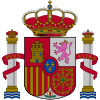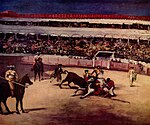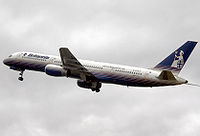Portal:Spain/Selected article
historical reference. . Either the page is no longer relevant or consensus on its purpose has become unclear. To revive discussion, seek broader input via a forum such as the village pump |
| Note: Article entries here that meet present portal standards are now being transcluded directly on the main portal page. However, this page should be retained for historical reference. |
Selected article 1
Portal:Spain/Selected article/1

One the morning of 30 December 2006 an explosion occurred in the carpark building module D, which is attached to terminal 4. The incident was first recorded at 08:34 (
Selected article 2
Portal:Spain/Selected article/2

The
It is thought that palms were originally planted in this location as early as the 5th century BC by
Selected article 3
Portal:Spain/Selected article/3

The
A seven-member panel was selected among the elected members of the Cortes to work on a draft of the Constitution to be submitted to the body. These came to be known, as the media put it, as the padres de la Constitución or "fathers of the Constitution". These seven people were chosen to represent the wide (and often, deeply divided) political spectrum within the Spanish Parliament, while the leading role was given to then ruling party and now defunct Unión de Centro Democrático. Writing the preamble of the constitution was considered an honour, and a task requiring great literary ability. The person chosen for this purpose was Enrique Tierno Galván. As well as this, the constitution recognises the existence of nationalities and regions.
Selected article 4
Portal:Spain/Selected article/4

The
Before
Selected article 5
Portal:Spain/Selected article/5

Bullfighting or tauromachy (Spanish: toreo, corrida de toros or tauromaquia; Portuguese tourada, corrida de touros or tauromaquia) is a traditional spectacle of Spain, Portugal, some cities in southern France, and several Latin American countries. Its origin is unknown, though it has been suggested that it was originally brought to Spain by the Visigoths. A link to the old culture of Crete has also been proposed.
The tradition, as it is practiced today, involves professional performers (in Spanish toreros or
Selected article 6
Portal:Spain/Selected article/6

Museo Nacional Centro de Arte Reina Sofía is the official name of Spain's national museum of 20th century art. The museum is commonly referred to as Museo Reina Sofía, Queen Sofia Museum, or The Sofia. The museum was inaugurated on 10 September 1992 and is named after Queen Sofia of Spain. The museum is located in Madrid at the southern area of the 'Golden Triangle of Art'.
The museum focuses mainly on Spanish art. Highlights of the museum include excellent collections of Spain's two greatest 20th century masters,
Selected article 7
Portal:Spain/Selected article/7

The
The current coat of arms was adopted on December 19, 1981, when it replaced the model of 1977 which, in turn, replaced the model of 1945, considered the official coat of arms of Francoist Spain. The coat of arms was the only changing element in those years. The colours previously defined in the constitution were amarillo (yellow) and rojo (red). Traditionally, the middle stripe was defined by the more archaic terms amarillo gualda (
Selected article 8
Portal:Spain/Selected article/8

The
According to Gaelic legend embodied in the 11th-century compilation Lebor Gabala Erren— the "Book of Invasions"— King Breogán, the founding father of the Galician Celtic nation, constructed here a massive tower of such a grand height that his sons could see a distant green shore from its top. The glimpse of that distant green land lured them to sail north to Ireland. A colossal statue of Breogán has been erected near the Tower.
Selected article 9
Portal:Spain/Selected article/9

The Biblioteca Nacional de España ('The National Library of Spain') is a major public library, the largest in Spain. It is located in Madrid near the Paseo de Recoletos. Founded in 1711, the Library was originally The Royal Public Library of King Philip V. It housed some 60,000 books by 1752, by which time it had become a legal deposit library. The Library continued to grow, and had significant royal patronage throughout the 18th century. By 1836 it had been renamed as The National Library of Spain ('Biblioteca Nacional de España'), and by 1850 it housed some 200,000 items. In 1896 the Library moved to the current location in center Madrid. The Madrid premises are shared with the
Its current catalog is called the Bibliografía Española. It indexes some 6,000,000 books and journals, 25,000 manuscripts, and 240,000 rare books. In addition to books, maps and manuscripts, it holds collections of visual material such as drawings, posters, and photographs.
Selected article 10
Portal:Spain/Selected article/10

Ceuta's strategic location has made it the crucial waypoint of many cultures' trade and military ventures — beginning with the
Selected article 11
Portal:Spain/Selected article/11 Rockdelux is a popular music magazine published monthly in Spain. Rockdelux was first published in November 1984, and since then has accumulated over 200 editions, celebrating its 200th in October 2002, when it released a list of the 200 greatest international albums of all time, according to the magazine's staff. Rockdelux's brief is to serve a specific section of the public who are passionate about music, and its focus has been to concentrate on new and more alternative artists from both Spain and the outside world (termed "international").
It has an extensive review section, covering mainly new musical releases and re-releases, but also covers other music-related subjects such as live concerts and videos and features reviews of new books and graphic novels. Unlike many other review sections in popular magazines, it eschews the trend of giving a numerical value to each review, which are purely composed of written text summing up the release's values. During its tenure within the industry, Rockdelux has been the recipient of various awards for music publication of the year from such organisations as Radio 3, Cadena SER and Iberpop amongst others.
Selected article 12
Portal:Spain/Selected article/12

A
(on Tenerife, buses are called guaguas), the service was discontinued.Selected article 13
Portal:Spain/Selected article/13

Surface wind 350/6 kt, visibility 4 km, thunderstorm with heavy rain, cloud 3-4 octas at 1,500 feet, 1-2 octas cumulonimbus at 3,000 feet, 5-7 octas at 4,000 feet, temperature 20°C/ dewpoint 20°C, QNH 1010 mb, remarks recent rain.
The crew initially executed the
Selected article 14
Portal:Spain/Selected article/14

The
Raised after the war, she was towed to Newport, Rhode Island where she served as a receiving ship. After a refit in 1912, she was transferred to Annapolis, Maryland to serve as a station ship, replacing the USS Hartford. Until 1940, one of the Reina Mercedes' roles was as a brig for the Naval Academy---cadets undergoing punishment were required to spend all time not in classes or at drills aboard the ship, sleeping in hammocks at night, for periods of up to two months. This practice was discontinued in 1940, to be replaced with confinement to rooms in Bancroft Hall. Other roles filled by the Reina Mercedes included service as a berthing barge for enlisted personnel assigned to the Academy during World War II, a lookout and harbor control center. It was a common joke at the time to refer to the Reina Mercedes as the "fastest ship in the fleet", since she was tied "fast" to the seawall.
Selected article 15
Portal:Spain/Selected article/15

The
On November 5, 1913, during the war with Morocco, a Spanish expeditionary squadron became the first organized military air unit to see real combat during the first organized bombing in history. During this war, the Spanish Military Aviation was divided in two: The Spanish Republic Air Forces (Fuerzas Aéreas de la República Española-FARE), created by the republican government and the National Aviation (Aviación Nacional), created by the army in revolt. At first, the republican air forces had the control of the majority of the territory using the Soviet
Selected article 16
Portal:Spain/Selected article/16

The
Selected article 17
Portal:Spain/Selected article/17
There have been
Selected article 24
Portal:Spain/Selected article/24

One the morning of 30 December 2006 an explosion occurred in the carpark building module D, which is attached to terminal 4. The incident was first recorded at 08:34 (

